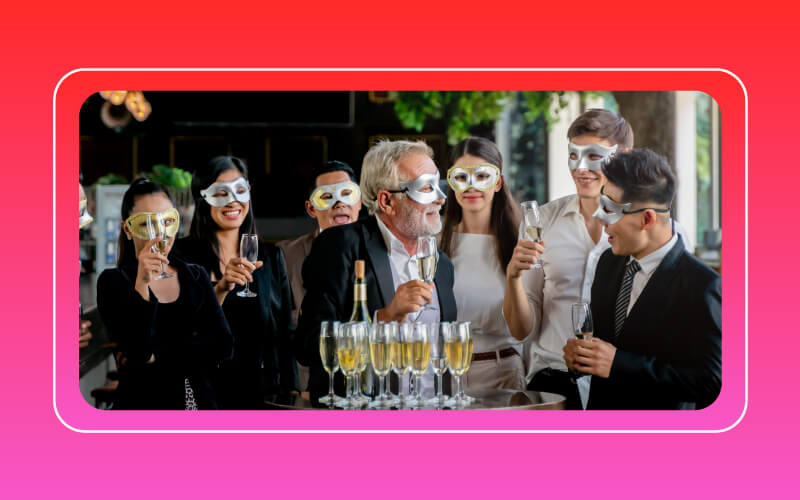Event sponsorship is a powerful way for brands to gain visibility, engage with new audiences, and build meaningful relationships within their industry. For event organizers, sponsorships provide crucial funding, helping them offer enhanced experiences to attendees. With the right strategy, sponsorship opportunities for events can be a win-win for both sponsors and organizers.
In this event sponsorship guide, we’ll explore strategies, examine effective examples, and highlight the benefits of event sponsorship brings to everyone involved.
What is Event Sponsorship
Event sponsorship is financial or in-kind support given by a brand, company, or individual to an event in exchange for promotional opportunities. It’s a mutually beneficial relationship: sponsors gain exposure to a target audience, while organizers receive funding or resources to enhance the event experience.
For example, tech companies often sponsor conferences where they can demonstrate their products to tech-savvy attendees and sports brands sponsor sports events to reach fitness-oriented audiences.
Why Companies Invest in Event Sponsorships
Sponsorship allows companies to:
1. Gain Brand Exposure: Placing a brand name or logo in front of a relevant audience builds awareness and recognition.
2. Reach Targeted Audiences: Sponsorship opportunities for events allow companies to engage directly with specific demographics.
3. Enhance Brand Image: Sponsorship aligns brands with the positive attributes of an event, increasing credibility.
4. Create Engaging Experiences: Sponsorship opportunities for events help brands create unique activations, helping attendees interact meaningfully with products or services.
5. Generate Leads: By providing exclusive offers or interactive experiences, sponsors can capture valuable leads for future engagement.
Benefits of Event Sponsorship
For both sponsors and event organizers, there are a few benefits of event sponsorship:
For Sponsors
Direct Audience Access: Events bring together people who share a common interest and are thus more likely to know or engage with the sponsor brand.
Lead Generation: Sponsors can get leads from potential customers through contests or exclusive offers during sponsorship.
Enhanced Visibility: Sponsors can get higher placements through event-related materials; hence, recalling the brand becomes easier.
Long-Term Partnerships: Successful sponsorships can lead to long-term brand-event partnerships, providing consistent benefits over time.
For Event Organizers
Financial Support: Sponsorships offer essential funding, covering event costs and expanding resources.
Audience Growth: Sponsors often bring their audiences to the event, helping it grow.
Enhanced Attendee Experience: Sponsor-provided resources can improve the event quality, adding value to attendee experiences.
Increased Credibility: Securing reputable sponsors enhances the event’s credibility and can attract more attendees.
Event Sponsorship Strategies: Tips For Organizers to Deliver Sponsor Success
To help your event sponsors succeed and keep them coming back, organizers should consider these valuable strategies:
Strategy 1: Find the Right Sponsors
Start off with event planning to find the right sponsors for your events. Look for companies that naturally align with your event’s theme, industry, and audience. Focus on those with shared values and a real interest in the event’s goals.
Strategy 2: Offer Custom Sponsorship Packages
Provide flexible sponsorship options to appeal to a range of sponsors. For instance, a “Gold Sponsor” might enjoy top-tier visibility and branding exclusivity, while a “Bronze Sponsor” can still gain valuable exposure but at a more accessible level.
Strategy 3: Prioritize Audience Engagement
Sponsors are more likely to join if they see real ways to connect with your audience. Look beyond logo placements by incorporating interactive activities, branded spaces, or giveaways that immerse sponsors directly in the event experience.
Strategy 4: Boost Digital Visibility
With many events going hybrid or virtual, sponsors value digital exposure more than ever. Consider virtual booths, online ads, and social media features to expand a sponsor’s reach beyond just the physical event.
Strategy 5: Craft a Compelling Event Sponsorship Proposal
Make a proposal that’s easy to understand and showcases the benefits such as audience reach, branding opportunities, and special perks like VIP access.
Strategy 6: Show Results to Measure ROI
Sponsors need proof of their investment’s impact. Share event metrics like engagement rates, social media impressions, lead numbers, and survey feedback after the event. A successful recap can help secure their support in the future.
Measuring Event Sponsorship Success
Measuring the sponsorship success of events is essential for both sponsors and organizers to understand the return on investment (ROI). Here are several critical areas to consider when evaluating sponsorship performance:
1. Brand Visibility and Awareness
A key goal of sponsorship opportunities for events is boosting brand awareness. Here are some ways to measure how well a sponsor’s brand reaches the audience:
- Impressions: Track the number of times the sponsor’s brand engagement whether on banners, social media, the event website, or the mobile event app. High impressions mean more people see the brand, which usually leads to better awareness.
- Reach: Focus on how many unique people saw the sponsor’s brand, which gives a clearer sense of actual exposure. This is especially useful for digital channels where you can see audience demographics, ensuring that the brand reached its ideal target group.
- Social Media Engagement: Look at the likes, shares, comments, and mentions for posts featuring the sponsor’s brand. A high engagement rate means the audience didn’t just see the brand but took action, increasing recognition and recall.
2. Audience Engagement
Audience engagement shows how well the sponsor connected with attendees, leaving a memorable impression that reinforces the brand’s message. Here’s how to gauge it:
- Booth Visits: If the sponsor has a booth or display at the event, track how many people stopped by. You can do this manually or through digital tools like RFID or NFC tracking to see not only who stopped by but also how long they stayed.
- Participation in Brand Activations: Many sponsors offer interactive experiences like think contests, product demos, or VR. Count how many attendees joined in, and gather their feedback to understand the activation’s appeal and impact.
3. Lead Generation and Data Capture
For sponsors aiming to gather leads, events offer a valuable chance to connect with potential customers. Here’s how to measure success in this area:
- Number of Leads Captured: Track how many leads the sponsor gathered through booth visits, online forms, or sponsored activities. Try to break down these leads by type (e.g., qualified, new, repeat customers) to understand their quality.
- Lead Conversion Rate: Measure how many leads turned into actual sales or consultations in the weeks or months after the event. This conversion rate provides a clear picture of how valuable the sponsorship was and helps calculate the ROI.
4. Brand Sentiment and Perception
Knowing how people feel about the brand, not just how many saw it, matters a lot. Looking at sentiment insights shows if the sponsorship made people like the brand.
- Social Listening Tools: Use social listening tools to know what people say about the sponsor’s brand and event hashtags. Check for words that show if people felt good or bad about the brand’s role.
- Net Promoter Score (NPS): Some sponsors want to see how loyal attendees are and if they’d tell others about the brand. NPS surveys work well to get this info for brands that care more about keeping customers for a long time than making quick sales.
5. Sales Impact and Revenue Generation
Some sponsors aim to increase sales now or in the future through sponsorship opportunities for events. In these cases, the effect on sales becomes a crucial way to measure success.
- Sales Generated at the Event: When sponsors can sell their goods or services right at the event, keeping track of sales numbers gives a clear picture of the sponsorship’s return on investment. Measure the total revenue made and compare it to what was spent on sponsorship to see if it was profitable.
- Post-Event Sales Increase: Some sponsors may experience a delayed revenue boost after the event, as attendees make purchasing decisions over time. By tracking sales data following the event, sponsors can gauge the long-term impact of their participation.
6. Sponsor Satisfaction and Retention Rate
From the organizer’s perspective, a key measure of success is whether sponsors are satisfied and interested in future sponsorship opportunities for events.
- Sponsor Surveys and Feedback: Collect feedback from sponsors about their experience, including the value they saw and the support event organizers provided. Happy sponsors tend to come back for future events, which helps create long-term partnerships.
- Retention Rate: Monitor how many sponsors renew their sponsorship each year. High retention rates show that sponsors find value in keeping up their investment and feel they’re meeting their goals.
Learn more: Rise of Contactless Event Check-In Solutions
Most Popular Event Sponsorship Examples
Here are four popular event sponsorship examples across various industries:
Tech Sponsorship – Software Demo Stations
In tech conferences, software companies often sponsor demo stations and can be a great sponsorship example. Here, attendees can experience products firsthand. These sponsorships help brands showcase their solutions to a targeted, tech-savvy audience, generating leads and building product awareness.
Healthcare Sponsorship – Wellness Zones
At healthcare and wellness expos, pharma or fitness brands sponsor wellness zones, providing free health screenings and advice. This aligns their brand with well-being, giving attendees a valuable experience while promoting health-oriented products or services.
Sports Sponsorship – VIP Lounges
Sports brands or fitness equipment companies often sponsor VIP lounges at large-scale sports events. These lounges offer exclusive amenities to VIPs to allow the sponsor to engage with high-value attendees.
Food and Beverage Sponsorship – Sampling Stations
Beverage and food brands sponsor sampling stations at music festivals or cultural events. This strategy allows brands to introduce their products directly to potential customers, creating positive associations in a relaxed, enjoyable setting.
Learn more: Why Event Organizers Need Event App Integrations
Final Thoughts
Event sponsorships have evolved beyond simple logo displays. They now offer a chance for brands to connect deeply and grow together. When event planners and sponsors follow proven methods and adjust to new trends, they can get the most out of their partnerships. This leads to long-term teamwork that brings real benefits to their audiences.







